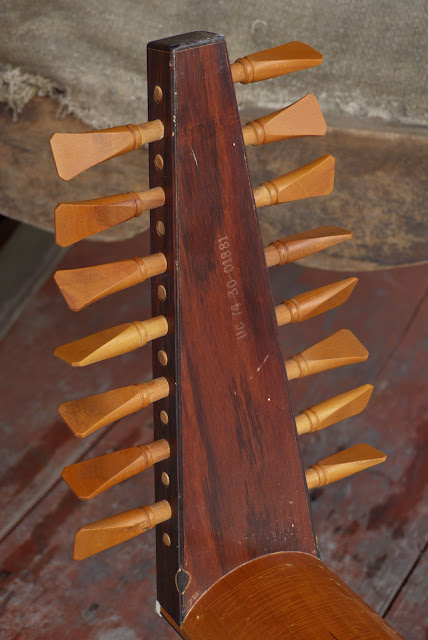1974 Lyn Elder XF-1 8-Course 15-String Lute
Before your read on, let me confess to a few sins -- first of all, I've installed metal frets on the neck of this instrument and second, I've modified and converted its bridge into a pin-style load for the strings. I had my reasons and mostly they were to make the instrument functional and accessible.
That said, this is a lute made in 1974 by Lyn Elder who lived in Sausalito, California at the time. It has 15 strings in 8 courses (the highest, typical for a lute, is single-strung). It's light as a feather, built from high-quality spruce over a cherry and Brazilian rosewood bowl, has a cherry neck and ebony fretboard, and a cherry bridge. Everything is cut expertly and it was, when made, beautifully crafted.
Time wasn't kind to it, however, and when this came to my shop via some friends a couple years ago (it must be, now?), the bridge was unglued and split and the fingerboard had developed a hair of relief to it. There were old repairs done to it to shore it up (small hairline crack repairs with cleats to the back in two places and two places on the top), and as I've mentioned I went a few steps forward and made it into a "player's lute" with the addition of fixed frets, a bridge reglue, new bone nut, and modification of the bridge to get the action to where it should be and the strings mounted in such a way as to not rip the bridge off again.
I have to say, after getting it all strung-up and playing, I was totally shocked at just how light-tension lute strings are. People have said on the net that they're like playing rubber bands even compared to classical strings -- and they are! One's technique really has to change to use this instrument and it's almost like playing a gut-strung banjo or really lightly-strung electric guitar.
The body is 20" long and 12" wide. It has a 25" scale length and the frets on the face are wood.
My cardinal sin was replacing the tied-nylon frets with these standard guitar frets, following the lute's 25" scale length as dialed-in by the original wooden frets on the face of the instrument. The nut is a wild 2 3/4" wide so it can house all 8 courses.
In the soundclip I have it tuned low-to-high CDEADGBE so I can play it (like guitar with a C&D drone on the bottom), though "standard" tuning for this scale length (tenor lute) is DFGCFADG -- something would never be able to figure-out and a tuning I'm not sure the LaBella 8-course lute set I have on it (strung with octaves) should be tuned to, really.
The rosette is gorgeous and is reinforced underneath with a few bars of ebony.
The bracing on this instrument is a simple one-two-three ladder bracing.
The bridge originally had a face that looked like the tie-block of a classical guitar bridge. That meant that setting the action height was -- well -- impossible. I was also suspicious of this bridge holding all of that tension (let's admit -- it had pulled itself off before), so I modified the design for a wide, ramped-up saddle that terminates at the front edge.
I then drilled holes and slots to pop in balled-up string-ends and then lock the ends in place in the slots in front of the holes. I've used this on ukes before and was happy with the way it works, though a small peg to hold the string in place (so it doesn't slip back out of the slot) while it's tuned-up helps when re-stringing.
the pegbox is awesome and the cherry pegs are fit perfectly.
While the bowl has a couple of small repaired hairline cracks, it's held-up well over the years and looks great. There are a number of buckle-related scratches on it, however.
The back of the pegbox has rosewood veneer... and a cigarette burn. Note the stamp for a UCal music program.
The original, beat-up, hard case comes with it. The inside looks nice, however!



















Comments